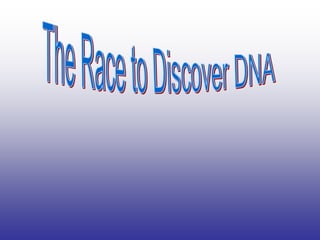
HistoryofDNA.ppt
- 2. Learner Outcomes • I can describe the major experiments that led to the discovery of DNA as the genetic material.
- 4. How do we know that all of our genetic information comes from DNA? • What type of experiment would you design to determine that DNA is the source of all genetic information?
- 5. Griffith’s Experiment with Pneumonia and the accidental discovery of Transformation • Frederick Griffiths was a bacteriologist studying pneumonia • He discovered two types of bacteria: – Smooth colonies – Rough colonies CONCLUSION: The smooth colonies must carry the disease!
- 6. Griffith’s Experiment with Pneumonia and the accidental discovery of Transformation • When heat was applied to the deadly smooth type… • And injected into a mouse… • The mouse lived!
- 7. • Griffith injected the heat-killed type and the non-deadly rough type of bacteria. • The bacteria “transformed” itself from the heated non-deadly type to the deadly type. Griffith’s Experiment with Pneumonia and the accidental discovery of Transformation
- 8. Griffith’s Experiment did not prove that DNA was responsible for transformation How would you design an experiment to prove that DNA was responsible for transformation?
- 9. Avery, McCarty, and MacLeod Repeated Griffith’s Experiment Oswald Avery Maclyn McCarty Colin MacLeod
- 10. Avery, McCarty, and MacLeod Added the non-deadly Rough Type of Bacteria to the Heat-Killed Smooth Type Carbohydrates Lipids Proteins RNA DNA To the Heat-Killed Smooth Type, added enzymes that destroyed…
- 12. The Hershey-Chase Experiment Alfred Hershey & Martha Chase worked with a bacteriophage: A virus that invades bacteria. It consists of a DNA core and a protein coat DNA Protein coat
- 13. Protein coats of bacteriophages labeled with Sulfur-35 DNA of bacteriophages labeled with Phosphorus-32 Bacterium Bacterium Phage Phage 1. Hershey and Chase mixed the radioactively-labeled viruses with the bacteria The viruses infect the bacterial cells.
- 14. Protein coats of bacteriophages labeled with Sulfur-35 DNA of bacteriophages labeled with Phosphorus-32 2. Separated the viruses from the bacteria by agitating the virus- bacteria mixture in a blender
- 15. Protein coats of bacteriophages labeled with Sulfur-35 DNA of bacteriophages labeled with Phosphorus-32 3. Centrifuged the mixture so that the bacteria would form a pellet at the bottom of the test tube 4. Measured the radioactivity in the pellet and in the liquid
- 16. The Hershey-Chase results reinforced the Avery, McCarty, and MacLeod conclusion: DNA carries the genetic code! However, there were still important details to uncover…
- 17. How did DNA: 1. Store information? 2. Duplicate itself easily? These questions would be answered by discovering DNA’s structure
- 18. The Race to Discover DNA’s Structure
- 19. Learner Outcomes • I can describe the structure of a DNA molecule. • I can explain the process of DNA replication.
- 20. Standards Addressed • Describe the basic structure and function of DNA, mRNA, tRNA, amino acids, polypeptides, and proteins (e.g., replication, transcription, and translation) SC-HS-3.4.5 SC-HS-3.4.1 • Describe the experiments of major scientists in determining both the structure of DNA and the central dogma.
- 21. The Race to Discover DNA’s Structure Linus Pauling 1940s Discovered the alpha- helical structure of proteins.
- 22. The Race to Discover DNA’s Structure 1950 Chargaff’s Rule: Equal amounts of Adenine and Thymine, and equal amounts of Guanine and Cytosine Erwin Chargaff Why do you think the bases match up this way? Purine + Purine = Too wide Pyrimidine + Pyrimidine = Too Narrow Purine + Pyrimidine = Perfect Fit from X-ray data
- 23. The Race to Discover DNA’s Structure Maurice Wilkins Rosalind Franklin X-Ray diffraction image of DNA taken by Franklin in 1951
- 24. The Race to Discover DNA’s Structure James Watson Francis Crick 1953 Compiled data from previous scientists to build a double-helical model of DNA
- 25. The Race to Discover DNA’s Structure was Over • DNA is made up of: – Four nucleotides: Adenine, Thymine, Guanine and Cytosine – These follow the rules of base-pairing: • Adenine bonds with Thymine • Guanine bonds with Cytosine – A sugar-phosphate backbone • DNA is arranged in an double-helix
- 26. DNA Replication • The double helix did explain how DNA copies itself • We will study this process, DNA replication, in more detail
- 27. How does DNA replicate? Conservative Semi-Conservative Dispersive Hypotheses:
- 28. 1. Bacteria cultured in medium containing a heavy isotope of Nitrogen (15N) Meselson-Stahl Experiment
- 29. 2. Bacteria transferred to a medium containing elemental Nitrogen (14N) Meselson-Stahl Experiment
- 30. Meselson-Stahl Experiment 3. DNA sample centrifuged after First replication
- 31. Meselson-Stahl Experiment 4. DNA sample centrifuged after Second replication
- 32. DNA Replication The “parent” molecule has two complementary strands of DNA. Each is base paired by hydrogen bonding with its specific partner: A with T G with C
- 33. DNA Replication The first step in replication is the separation of the two strands.
- 34. DNA Replication Each parental strand now serves as a template that determines the order of the bases along a new complementary strand.
- 35. DNA Replication The nucleotides are connected to form the sugar- phosphate backbones of the new strands. Each “daughter” DNA molecule consists of one parental strand and one new strand.
- 36. The Race to Replicate DNA • Two teams: A and B • Individually, each team member will run to the board to add a nucleotide to the “unzipped” strand of DNA. • The first team to finish base-pairing their DNA correctly will win the game.
- 37. Standards Addressed: • Describe the basic structure and function of DNA, mRNA, tRNA, amino acids, polypeptides, and proteins (e.g., replication, transcription, and translation) SC-HS-3.4.5 SC-HS-3.4.1 • Use mRNA codon charts to determine amino acid sequences of example polypeptides SC-HS-3.4.1 SC-H- UD-S-3
- 38. Learner Outcomes • I can explain the process of protein synthesis. • I can transcribe DNA to mRNA and use a codon chart to translate mRNA to its corresponding amino acid sequence.